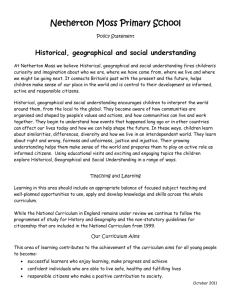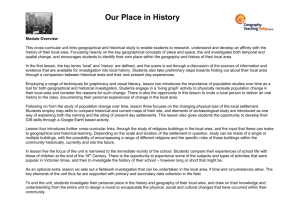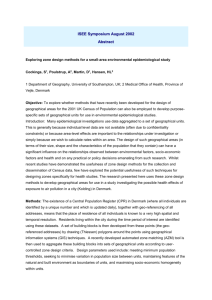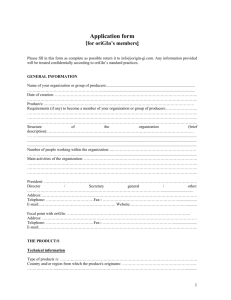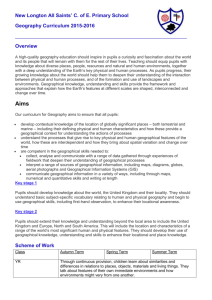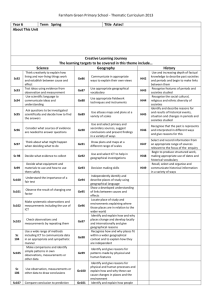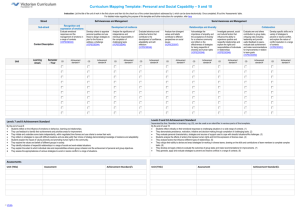Speaking and listening assessment guidelines: levels 1 and 2
advertisement
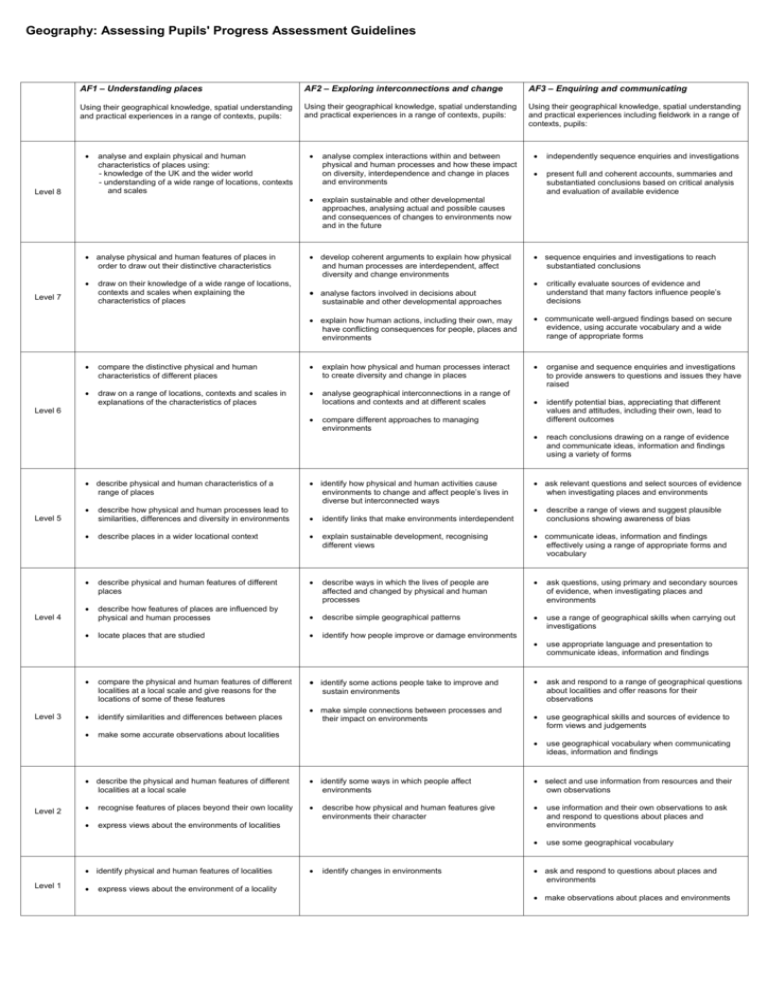
Geography: Assessing Pupils' Progress Assessment Guidelines AF1 – Understanding places AF2 – Exploring interconnections and change AF3 – Enquiring and communicating Using their geographical knowledge, spatial understanding and practical experiences in a range of contexts, pupils: Using their geographical knowledge, spatial understanding and practical experiences in a range of contexts, pupils: Using their geographical knowledge, spatial understanding and practical experiences including fieldwork in a range of contexts, pupils: Level 8 analyse and explain physical and human characteristics of places using: - knowledge of the UK and the wider world - understanding of a wide range of locations, contexts and scales analyse physical and human features of places in order to draw out their distinctive characteristics Level 7 draw on their knowledge of a wide range of locations, contexts and scales when explaining the characteristics of places analyse complex interactions within and between physical and human processes and how these impact on diversity, interdependence and change in places and environments independently sequence enquiries and investigations present full and coherent accounts, summaries and substantiated conclusions based on critical analysis and evaluation of available evidence explain sustainable and other developmental approaches, analysing actual and possible causes and consequences of changes to environments now and in the future develop coherent arguments to explain how physical and human processes are interdependent, affect diversity and change environments sequence enquiries and investigations to reach substantiated conclusions sustainable and other developmental approaches critically evaluate sources of evidence and understand that many factors influence people’s decisions explain how human actions, including their own, may have conflicting consequences for people, places and environments communicate well-argued findings based on secure evidence, using accurate vocabulary and a wide range of appropriate forms organise and sequence enquiries and investigations to provide answers to questions and issues they have raised identify potential bias, appreciating that different values and attitudes, including their own, lead to different outcomes reach conclusions drawing on a range of evidence and communicate ideas, information and findings using a variety of forms analyse factors involved in decisions about compare the distinctive physical and human characteristics of different places explain how physical and human processes interact to create diversity and change in places draw on a range of locations, contexts and scales in explanations of the characteristics of places analyse geographical interconnections in a range of locations and contexts and at different scales Level 6 describe physical and human characteristics of a range of places identify links that make environments interdependent describe places in a wider locational context explain sustainable development, recognising different views communicate ideas, information and findings effectively using a range of appropriate forms and vocabulary describe physical and human features of different places describe ways in which the lives of people are affected and changed by physical and human processes ask questions, using primary and secondary sources of evidence, when investigating places and environments describe how features of places are influenced by physical and human processes describe simple geographical patterns locate places that are studied use a range of geographical skills when carrying out investigations identify how people improve or damage environments use appropriate language and presentation to communicate ideas, information and findings ask and respond to a range of geographical questions about localities and offer reasons for their observations use geographical skills and sources of evidence to form views and judgements use geographical vocabulary when communicating ideas, information and findings compare the physical and human features of different localities at a local scale and give reasons for the locations of some of these features identify similarities and differences between places make some accurate observations about localities identify some actions people take to improve and sustain environments make simple connections between processes and their impact on environments describe a range of views and suggest plausible conclusions showing awareness of bias describe the physical and human features of different localities at a local scale identify some ways in which people affect environments select and use information from resources and their own observations recognise features of places beyond their own locality express views about the environments of localities use information and their own observations to ask and respond to questions about places and environments use some geographical vocabulary identify physical and human features of localities Level 1 ask relevant questions and select sources of evidence when investigating places and environments Level 4 Level 2 identify how physical and human activities cause environments to change and affect people’s lives in diverse but interconnected ways describe how physical and human processes lead to similarities, differences and diversity in environments Level 5 Level 3 compare different approaches to managing environments express views about the environment of a locality describe how physical and human features give environments their character identify changes in environments ask and respond to questions about places and environments make observations about places and environments


